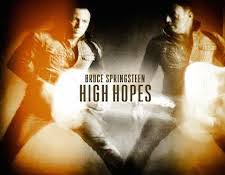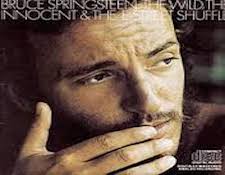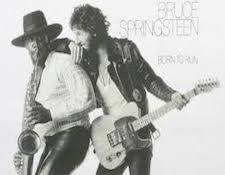It’s the time of year for saving money!
I first heard Bruce Springsteen in 1976 with the release of his seminal album Born To Run. This landmark LP features one of the Boss’ most iconic album covers with a smiling Springsteen pictured sideways and his elbow resting on the shoulder of Clarence Clemons, aka, “The Big Man.” This album catapulted Springsteen first into national fame and soon after international, if not stratospheric notoriety.
 Upon hearing this album, I immediately became a huge fan. I went up to the Revco Drug Store, where I once worked as a stock boy, and found two other Springsteen albums. One was The Wild, The Innocent And The E Street Shuffle. I could not come close to playing “Kitty’s Back In Town” and “Rosalita” often enough. Both songs are still on my all time favorite list.
Upon hearing this album, I immediately became a huge fan. I went up to the Revco Drug Store, where I once worked as a stock boy, and found two other Springsteen albums. One was The Wild, The Innocent And The E Street Shuffle. I could not come close to playing “Kitty’s Back In Town” and “Rosalita” often enough. Both songs are still on my all time favorite list.
Greetings From Asbury Park, NJ was an album that I enjoyed in its entirety but “Blinded By The Light” and “Lost In The Flood” were real standouts. This album had a modest start with only about 25,000 copies sold in the first year of its 1973 debut. But soon after the release of “Born To Run” the sales of both previous albums picked up considerably. As did Springsteen’s popularity and my enjoyment of his music.
Something happened soon after that, or at least for me. His first three albums were mostly about girls and racing around through Central and Eastern New Jersey in, as noted on the song Lost In The Flood, “Chevy Stock Super Eight’s.” It was a time in the Springsteen’s’ career where he reflected on his youth growing up in New Jersey and the central importance in his life at the time- girls and cars. Something to which almost every teenaged boy can easily relate. Many adults as well!
 But something changed as Springsteen’s popularity increased. He became more political. His music became increasingly introspective and one might argue, more somber. Mostly gone were the upbeat songs about “Chevy Stock Super Eights” and in their place were more dramatic songs about war, poverty and the disparate conditions between the rich and the poor. Springsteen became a voice for the little guy, the person who was downtrodden and struggled to get by. He was basically growing up and using his popularity to voice a cause. He was not the first to do so, nor the last, and is well within his rights to become endeared to a cause or two. It’s his music and his message. His fans can enjoy the music and the message, or not. However, at that point, I basically of lost my interest in Springsteen.
But something changed as Springsteen’s popularity increased. He became more political. His music became increasingly introspective and one might argue, more somber. Mostly gone were the upbeat songs about “Chevy Stock Super Eights” and in their place were more dramatic songs about war, poverty and the disparate conditions between the rich and the poor. Springsteen became a voice for the little guy, the person who was downtrodden and struggled to get by. He was basically growing up and using his popularity to voice a cause. He was not the first to do so, nor the last, and is well within his rights to become endeared to a cause or two. It’s his music and his message. His fans can enjoy the music and the message, or not. However, at that point, I basically of lost my interest in Springsteen.
So it was with a certain amount of hesitation that I purchased his newest album, High Hopes, a collection of previously un-released concert songs from the past decade. I sort of splurged and purchased a 180g album version that came packaged with a 44.1 / 16 CD. Sort of the best of both worlds. That also allowed me to do a real time A / B test of the sonics of the album vs. the CD, playing the same song at the same time and switching back and forth between the phono and DAC settings on my preamp. More on that sometime in the future.
 High Hopes is, for the most part, a classic Springsteen rock and roll album. All of the songs on the album have been part of Springsteen’s standard concert set at some point or another. While there are really not any songs with the raw energy and fun enthusiasm of “Rosalita” or “Kitty’s Back In Town” it is an enjoyable album. This album is part and parcel of what you might hear live at a Springsteen concert.
High Hopes is, for the most part, a classic Springsteen rock and roll album. All of the songs on the album have been part of Springsteen’s standard concert set at some point or another. While there are really not any songs with the raw energy and fun enthusiasm of “Rosalita” or “Kitty’s Back In Town” it is an enjoyable album. This album is part and parcel of what you might hear live at a Springsteen concert.
While still somewhat political, as evidenced in the song “Heaven’s Wall,” a song inspired by the Vietnam Memorial in Washington, DC, the twelve songs on the album give a glimpse of Springsteen at a high level of creativity. The title song, “High Hopes,” is an upbeat, classic rock and roll song. As is “Just Like Fire Would” on side two.
On the liner notes, Springsteen clearly states that he thinks these songs are examples of some of his best writing. Obviously, this is music that is near and dear to his heart. These are songs that his fans have heard at live concerts but never before on a studio release. His goal was to set that right.
 Still, however, for those that purchase the album, you may well notice that the lead out groove in some cases is pretty wide. In fact, I timed side three and from the start of music on song one to the end of music on song three a scant 10:13 had elapsed. It almost begs the question “was there not room for one more song?”
Still, however, for those that purchase the album, you may well notice that the lead out groove in some cases is pretty wide. In fact, I timed side three and from the start of music on song one to the end of music on song three a scant 10:13 had elapsed. It almost begs the question “was there not room for one more song?”
Manifestly, this is Springsteen’s music. Music of which he is most proud and which inspires him. These songs have been played at concerts for mostly the past decade or so. Now this same music is on an album and CD for all his fans to enjoy.
So is this an album resplendent of the raucous fun of “Kitty’s Back In Town?” No, it certainly is not. Or is more typical of the politically based, anti war, anti establishment music that has been so associated with Springsteen since the early 80″s. Not especially, no.
What this album, and the accompanying CD delivers is a peek inside a concert headlined by Springsteen and the E Street Band. Playing the music they hold dear and which inspires them. Regardless if you like the 1970’s version of Springsteen or his more recent works, High Hopes delivers a Springsteen doing what he loves to do-being a rock and roll musician. This is Bruce performing the music he loves most. What can be wrong with that?





